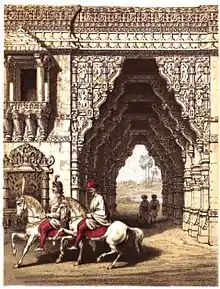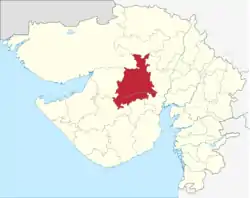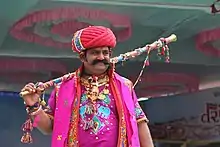Surendranagar district
Surendranagar is an administrative district in Saurashtra region of Gujarat state in India.[2] It has a population of approximately 1.7 million people. Surendranagar city, along with the twin city of Wadhwan, has a total of 400,000 inhabitants, and is known as "Camp".

Surendranagar district | |
|---|---|
District | |
 Location of district in Gujarat | |
| Coordinates: 22.73°N 71.51°E | |
| Country | |
| State | Gujarat |
| Region | Saurashtra |
| Headquarters | Surendranagar |
| Area | |
| • Total | 10,489 km2 (4,050 sq mi) |
| Elevation | 547 m (1,795 ft) |
| Population (2011)[1] | |
| • Total | 1,756,268 |
| • Density | 144.45/km2 (374.1/sq mi) |
| Languages | |
| • Official | Gujarati, Hindi |
| Time zone | UTC+5:30 (IST) |
| PIN | 363001 |
| Telephone code | 02752 |
| Vehicle registration | GJ 13 |
| Sex ratio | 0.924 ♀/♂ |
| Literacy | 72.13%census of 2011 |
| Website | surendranagardp |
Economy
In the past, Surendranagar was used by colonialists as a hill station, because of its dry environment that was beneficial for some physical as well as mental ailments. Surendranagar's dry air is still believed to be the best place in Gujarat to cure tuberculosis patients.
District capital Surendranagar, which lies under Municipality body is suffering from poor condition of roads and the two Causeways which join both the sides of city divided by Bhogavo River. Municipality body of city is considered to be a candidate for status of Municipal Corporation for a long time but due to some political reasons it never happen. It has the second highest number of educational institutes per capita. Many newspapers are published from Surendranagar in Gujarat.
Businesses
Many small and medium enterprises and industries are present, including confectionery, ceramics, pharmaceuticals, engineering plastics, bearings and spindles, and salt production. Wadhwan City is a major trade and processing centre for agricultural products, cotton, salt, pharmaceuticals, chemicals and plastics, textile bearings, ceramics, and sanitary ware.
Natural resources
Nearly 25 percent of India's salt supply comes from mining in the Surendranagar area. There are miles of Agar (Salt pans), especially in the Kharaghoda area. High-quality salt is produced in Zinzuwada, a desert area.
Textiles
Surendranagar is a hub of cotton and ginning activities in India, with a large number of ginning and pressing units. It is one of the largest producers of quality Shankar cotton in world. The Surendranagar Cotton Oil and Oilseeds Association Ltd.,( Government of India recognised) is a world-famous futures trading exchange for cotton. It was established in 1964 and is the first Cotton Future Trading Exchange in India.
Surendranagar City is also home to a big textile and clothing market, specialising in saris. Large clothing showrooms are located in the city on Jawahar Road and Vithal Press Road.
Demographics
According to the 2011 census Surendranagar district has a population of 1,756,268, with 909,917 males and 846,351 females[3] roughly equal to the nation of The Gambia[4] or the US state of Nebraska.[5] This gives it a ranking of 274th in India (out of a total of 640).[6] The district has a population density of 167 inhabitants per square kilometre (430/sq mi).[6] Its population growth rate over the decade 2001–2011 was 15.89%.[6] Surendranagar has a sex ratio of 929 females for every 1000 males,[6] and a literacy rate of 73.19%.[6]
At the time of the 2011 Census of India, 98.84% of the population in the district spoke Gujarati and 0.69% Hindi as their first language.[7]
76.82% of the population is Hindu. Caste wise residents include Brahmins, Kshatriya, Patels, Vankar as well as significant numbers of Bharvad, Rabari, Luhar Suthar, Kansara, Mochi and Sathwara .
Main Jain Temple, which is in the heart of the city, of Sri Vasupujyaswami Bhahvan is more than 100 years old.
Culture

Raj-Rajeshwari Temple, on National Highway Number 8 near Limbdi, is a large area of residences, hospitals, and schools. The temple features an exhibition of yoga performed by Rishiji. This temple has temples to three major gods—Brahma, Vishnu, and Mahesh—inside. It is the only such temple in Gujarat. The temple is noted for its architecture. (lack of info. Cannot find it via googlemap)
Trimandir - A very big temple known as the ‘Trimandir’ by Param Pujya Dada Bhagwan houses Lord Simandhar Swami, Shiv Swaroop, Krishna Bhagwan, other celestial deities.[8]
The famous kund known as "Gangavo" is located in Dedadara village. It was built in the 11th century.
Ranakadevi
According to legend, during the siege of Junagadh, Jayasimha Siddharaja fell in love with the queen of Khengara, Ranakdevi. He attacked Junagadh and killed Ra'Khengar to claim the fort and the queen, but she refused and fled. She escaped from the city towards the River Bhogaavo. After a long chase, she gave up and instead of becoming the queen of Junagadh she sacrificed her life by forming sati on the banks of Bhogavo River, near the city of Wadhwan. However, before she died she cursed that the river would not flow beyond that spot. There is a temple in honour of Ranakdevi on the banks of the river.
Notable people
- Anil Chavda a Gujarati poet, was born here.
- Dalpatram (1820-1898) a Gujarati language poet was born in Wadhwan city of Surendranagar district.
- Jhaverchand Meghani (1896–1947) poet, litterateur, social reformer and freedom fighter. Born in Chotila.[9]
- Shahabuddin Rathod a Gujarati comedian, hails from this district.
- Vipul K. Rawal a Hindi film writer was born in Surendranagar.
- Sukhlal Sanghvi (1880–1978) Jain scholar and philosopher. Born in Limbdi.[10]
References
- "Basic Data Sheet: District muli(08), Gujarat (24)" (PDF). Census of India. 2001.
- https://surendranagardp.gujarat.gov.in/en/home
- "Office of the Registrar General & Census Commissioner, India". censusindia.gov.in. Retrieved 14 October 2020.
- US Directorate of Intelligence. "Country Comparison:Population". Retrieved 1 October 2011.
Gambia, The 1,797,860 July 2011 est.
- "2010 Resident Population Data". U. S. Census Bureau. Retrieved 30 September 2011.
Nebraska 1,826,341
- "District Census 2011". Census2011.co.in. 2011. Retrieved 30 September 2011.
- 2011 Census of India, Population By Mother Tongue
- "The Surendranagar Trimandir". Retrieved 10 May 2018.
- "Jhaverchand Meghani – Life Part-1 : 1896–1922". Nanak Meghani. Retrieved 20 September 2011.
- Mohan Lal (2006). Encyclopaedia of Indian literature, Volume 5. New Delhi: Sahitya Akademi. ISBN 81-260-1221-8. p. 4215
External links
| Wikimedia Commons has media related to Surendranagar district. |
